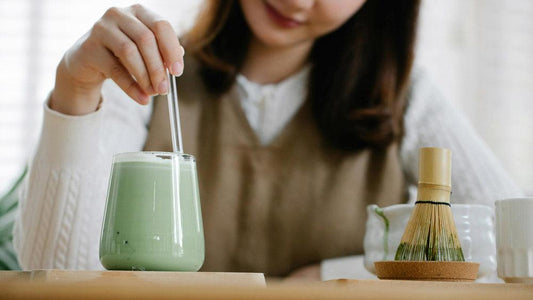
How to clean your matcha whisk (Chasen)?
Sébastien GELLESummarize the article with:
- Rinse (with lukewarm water, never with soap)
- Dry (on a support with the strands facing down, OR standing upright without a support to preserve the shape)
- Store (in a dry and well-ventilated place)
You have just finished your morning matcha ritual, your bowl is empty, and now you look at your beautiful bamboo whisk wondering: how do I clean it without damaging it ?
We completely understand. The chasen is a delicate, handcrafted item that deserves your full attention. The good news? Taking care of your matcha whisk is much simpler than you think.
In this guide, we share the exact method (the one we use ourselves at Blossom Matcha) to care for your chasen like a pro. Your whisk will thank you by giving you months of beautiful, creamy foams.
Summary
🚨 The 3 fatal mistakes to avoid
Before we begin, let's talk about what you should NEVER do with your chasen:
❌ NEVER use soap or dishwashing liquid : Bamboo absorbs everything, and you really don't want your next matcha to taste like lemony dishwashing liquid.
❌ NEVER put in the dishwasher : The delicate strands of your whisk will not survive this aggressive treatment.
❌ NEVER use boiling water : Intense heat can cause the bamboo to crack and deform the strands. Save it for your pasta, not your chasen.
Now that that's clear, let's move on to the correct method!
Cleaning your matcha whisk: the step-by-step method
The secret to a healthy chasen? Speed. The sooner you clean your whisk after use, the less time the matcha has to dry and become ingrained. Think of it as a closing ritual after your zen moment.
Step 1: Rinsing (warm water is your best friend)
Run your whisk under lukewarm tap water . Not hot, not cold, just lukewarm, a comfortable temperature for your hands. Let the water flow gently between the tines to loosen the first particles of matcha.
And we insist: no soap . Bamboo is porous; it would absorb residue and alter the delicate taste of your next matcha. Water is more than enough, we promise.
Step 2: "Whisking" (active cleaning)
Here's our favorite technique, the one that really makes a difference: fill a small bowl with clean, lukewarm water, then whisk it as if you were preparing matcha. Use "W" or zigzag motions for 10-15 seconds.
This action helps to dislodge all the tiny tea particles hidden deep within the leaves. It's effective, gentle, and a little meditative too.
What should I do if the matcha has dried on the whisk?
It happens to the best of us! If you forgot to clean your chasen immediately and the matcha hardened, don't panic.
Let it soak briefly in a bowl of lukewarm water (no more than a minute). Then, very gently rub the strands with your fingers to remove any residue. The bamboo will soften slightly with the water and release the trapped particles.
Drying and storage: the crucial anti-mold step
Here's the part many people overlook, yet it's THE key to preserving your whisk for a long time . Improper drying is the number one cause of mold, warping, and unpleasant odors. We're going to help you avoid that.
How to properly dry your Chasen?
After rinsing, gently shake your whisk over the sink to remove excess water. No need to torture it, a few flicks of the wrist will do.
Next (and this is crucial) you have two options depending on whether or not you own a whip holder:
If you don't have a whip stand : Dry it upright, strands facing up , resting on its base. This position helps preserve the natural curved shape of the strands and prevents them from drooping. Just make sure it's in a well-ventilated area where the moisture can evaporate freely.
The essential accessory: the whip holder (Kuse Naoshi)
If we had to recommend one accessory to transform your chasen interview, it would be the Kuse Naoshi (or Chasen Naoshi). It's a small ceramic holder, traditional in Japan, that has two superpowers:
- It allows for optimal drying . Your whisk is held bristles down in the holder, allowing air to circulate freely between all the bristles. No more trapped moisture.
- It preserves the curved shape of the strands . Between uses, the Kuse Naoshi gently holds the "heart" of your whisk open, preventing the strands from closing or becoming misshapen. The result? Your chasen retains its perfect shape and its ability to create that creamy lather we all love.
Where should I store my whisk once it's dry?
Once your chasen is completely dry (allow a few hours), store it in a dry place, away from moisture and direct sunlight .
A kitchen drawer, a shelf in your pantry, or even left on its stand if your kitchen isn't too humid. All these places work perfectly. However, avoid putting it back in its original box if it's not 100% dry.
✅ Good maintenance practices
| ✅ TO DO | ❌ DO NOT DO THIS |
|---|---|
| Rinse with lukewarm water immediately after use | Use soap, detergent or dishwashing liquid |
| Whisk in a bowl of clean water for a thorough cleaning | Place in the dishwasher |
| Store in a dry and well-ventilated place | Store while still damp or in its closed box |
| Soak a new chasen for 1–2 minutes before first use | Leave to soak for more than a minute (unless new) |
| Shake gently to remove excess water | Rub vigorously or twist the strands |
| Allow to air dry completely | Wipe with a cloth or dry with a hairdryer |
| Use a whisk holder to preserve the shape of the strands. | Lay the chasen flat or in a position that crushes the strands. |



